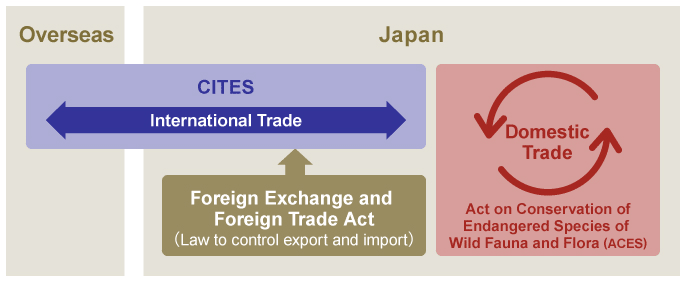What is CITES?
What is CITES?
Outline
The Convention on International Trade in Endangered Species of Wild Fauna and Flora (CITES) is called also the Washington Convention because it was adopted in 1973 in Washington D.C., USA.
Currently, many species of wild fauna and flora that form an irreplaceable part of nature are on the verge of extinction due to a variety of factors, including habitat loss and degradation caused by such as development and declination of traditional land-use, and over-exploitation, alien species, and climate change. While there are various factors, CITES is a treaty that aims to conserve species threatened by over-exploitation through international trade by implementing regulations on international trade in cooperation with exporting and importing countries.
History
At the United Nations Conference on the Human Environment (Stockholm Conference) in 1972, it was recommended that a conference be promptly convened to prepare and adopt a draft convention to regulate international trade in endangered species of wild fauna and flora. In response to this, the Convention was adopted in Washington DC, U.S. on March 3, 1973, and entered into force on July 1, 1975. Japan deposited the instrument of acceptance in 1980, and it came into effect in November 1980. March 3, the day the convention was adopted, was designated as World Wildlife Day.
Contents of the Convention
In order to prevent the extinction of species due to excessive international trade, CITES lists wildlife species for which regulation of international trade is considered necessary in its Appendices. The Appendices have three categories (Appendix Ⅰ to Ⅲ) according to the degree of threat of extinction and the nature of the regulation required. The species listed in Appendix Ⅰ and Ⅱ (species subject to regulation) are reviewed, deliberated upon, and revised at the Conference of the Parties held every two to three years.
AppendixⅠ
Species that are threatened with extinction and whose trade needs to be particularly tightly regulated because they are or may be affected by trade are listed. In principle, international trade for commercial purposes is prohibited. Although trade for scientific purposes, etc. is allowed, it requires a permit issued by the government of both the exporting and importing countries.
AppendixⅡ
Species that are not necessarily now threatened with extinction but could become endangered if trade is not strictly regulated are listed. Although international trade for commercial purposes is possible, it requires a document such as an export permit issued by the government of the exporting country.
AppendixⅢ
Species for which any Party needs the cooperation of other treaty parties for preventing or restricting exploitation within its own borders are listed. Although international trade for commercial purposes is possible, it requires an export permit issued by the government for exports originating from the listed countries. A certificate of origin is required for exports originating from countries other than those listed.
*Based on the Convention, each Party designates a Management Authority that is authorized to issue permits or certificates, and a Scientific Authority that advises the Management Authority on matters such as whether the transaction is likely to be detrimental to the survival of the species.
Japan's basic policy and measures
Japan's basic policy on the conservation of wildlife includes taking appropriate measures in accordance with the idea of sustainable use(*) of biological resources based on scientific data.
*This is the concept of harmonizing development activities and resource use with the conservation of ecosystems and the environment including permitting the harvest and use of biological resources within certain quantitative limits.
In order to properly implement international trade regulations under CITES, Japan performs border controls for imports and exports based on the Foreign Exchange and Foreign Trade Act (“Foreign Exchange Act”). Based on the convention, the Ministry of Economy, Trade and Industry and the Ministry of Agriculture, Forestry and Fisheries (specifically the Fisheries Agency) are designated as the Management Authorities which issue import/export permits, and the Ministry of the Environment and the Ministry of Agriculture, Forestry and Fisheries are designated as the Scientific Authorities which advise the Management Authorities.
| Management Authority | Ministry of Economy, Trade and Industry | Other than introduced from the sea |
|---|---|---|
| Ministry of Agriculture, Forestry and Fisheries (Fisheries Agency) | Introduced from the sea | |
| Scientific Authorities | Ministry of Agriculture, Forestry and Fisheries | Plants and aquatic animals |
| Ministry of the Environment | Terrestrial animals |
Please click here for more information on CITES procedures and related ministries and agencies for imports and exports (Ministry of Economy, Trade and Industry website).
For the species listed in Appendix Ⅰ of CITES, international trade for commercial purposes is prohibited in principle, and domestic trade in Japan is also regulated under the Act on Conservation of Endangered Species of Wild Fauna and Flora (“ACES”).
Click here for the regulations on domestic trade, etc. based on ACES.


